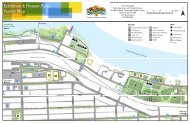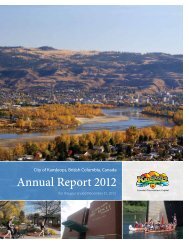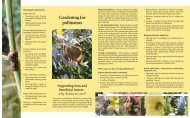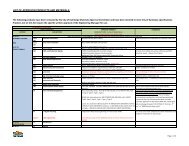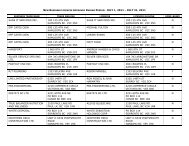Due to topography, existing growth, and anticipated steady <strong>future</strong> growth, local agricultural land is under pressure <strong>for</strong>development based on <strong>the</strong> land base remaining in <strong>the</strong> <strong>City</strong>. Map 2 (see Maps Section) identifies <strong>the</strong> restrictions to <strong>future</strong>growth based on a number <strong>of</strong> parameters such as environmentally sensitive lands, ALR land, hazard lands, and existingdeveloped areas. Bringing existing under-productive, but arable, agricultural lands into production may help supportagricultural land preservation.WHERE IS OUR FOOD COMING FROM? 1 BC is more reliant on imports <strong>of</strong> fruits and vegetables than o<strong>the</strong>r foods BC produced about 3.0, imported about 2.0, and exported about 1.6billion dollars worth <strong>of</strong> food in 2007 Approximately half <strong>the</strong> value <strong>of</strong> <strong>the</strong> food produced in BC (i.e., 1.6billion dollars out <strong>of</strong> <strong>the</strong> total value <strong>of</strong> food produced in BC <strong>of</strong> 3 billion dollars) is exported.Approximately 70% <strong>of</strong> BC’s imported vegetables came from <strong>the</strong> United States in 2007 <strong>of</strong> which about 17% came fromMexico with China also supplying 7% In 2007, 55% <strong>of</strong> BC’s imported fruit came from <strong>the</strong> United States (predominantly Cali<strong>for</strong>nia), about 8% came fromMexico and Ecuador respectively, 7% from China and 6% from Chile and <strong>the</strong> remaining 13% came from 30 o<strong>the</strong>r nations About 1.3 billion dollars <strong>of</strong> fish and 600 million dollars <strong>of</strong> livestock and meat products were produced in BC in 2007 Approximately 70% <strong>of</strong> fats and vegetables, 60% <strong>of</strong> cereals, fruit and nuts and fish, 50% <strong>of</strong> shellfish, and 40% <strong>of</strong> meatimported into BC in 2007 came from <strong>the</strong> United StatesTHE IMPORTANCE OF SUPPORTING LOCAL PRODUCERS 2In 2010, <strong>the</strong> top five Canadian menu trendsincluded locally sourced food, sustainability,organic produce, artisanal cheese, andsimplicity/back to basics.Local agriculture helps local economies and local farmers;Food that does not travel long distances to arrive at one's plate is <strong>of</strong>ten fresher;Local agriculture makes our lives more resilient and self-sufficient. The more we control where our food and money iscoming from, <strong>the</strong> more resilient we are;Local agriculture preserves green belts; andThere are stricter health and safety standards in place <strong>for</strong> food grown in Canada than that in <strong>the</strong> United States andMexico, places where much <strong>of</strong> our food comes from.1 (Ostry, Miewald, & Beveridge, 2011)2 (Ladner, 2011)CITY OF KAMLOOPS 12
HISTORY OF LOCAL AGRICULTUREAn extensive historical timeline detailing <strong>the</strong> agricultural history <strong>of</strong> <strong>Kamloops</strong>has been developed by <strong>City</strong> Planning staff as a living document to provideinsight into past agricultural successes and failures, trends, and potentialopportunities <strong>for</strong> moving <strong>for</strong>ward with <strong>the</strong> industry. The document is alsointended to serve as a guide <strong>for</strong> new farmers interested in farming in <strong>the</strong><strong>Kamloops</strong> region.Post-contact, <strong>Kamloops</strong> has been a self-sufficient food producer since <strong>the</strong>1880s, particularly with <strong>the</strong> introduction <strong>of</strong> <strong>the</strong> railways and <strong>the</strong> ability to shiplocal products to markets. Agriculture has been an important livelihood andeconomic factor in and around <strong>Kamloops</strong> since this time. The Hudson's BayCompany was likely responsible <strong>for</strong> <strong>the</strong> first agricultural activity in <strong>the</strong> areaTo view <strong>the</strong> historical timeline or shareadditional historical agriculture events <strong>for</strong> <strong>the</strong>timeline, please visit:www.kamloops.ca/environment/landagricultureplan.shtmlor contact <strong>the</strong><strong>Kamloops</strong> Museum & Archives at250-828-3576.with <strong>the</strong> cultivation <strong>of</strong> timothy grass <strong>for</strong> <strong>for</strong>age <strong>for</strong> horses used in <strong>the</strong> fur trade and <strong>the</strong> import <strong>of</strong> cattle <strong>for</strong> beef and dairy.Potatoes were <strong>the</strong> main staple produced by <strong>the</strong> Hudson's Bay Company on <strong>the</strong> North Shore site <strong>of</strong> <strong>the</strong> <strong>for</strong>t in <strong>the</strong> mid-1800s. Agreat deal <strong>of</strong> agricultural experimentation took place during this time.The first ranch was started on <strong>the</strong> north side <strong>of</strong> <strong>the</strong> South Thompson River just east <strong>of</strong> <strong>Kamloops</strong> in <strong>the</strong> 1860s. Later in thatdecade, one <strong>of</strong> <strong>the</strong> first <strong>of</strong> many orchards in <strong>the</strong> <strong>Kamloops</strong> area was started at Tranquille.As <strong>the</strong> local agricultural sector grew, so too did its support system. An annual Inland Agriculture Association event thatdisplayed local crops and livestock was initiated, and processing facilities <strong>for</strong> livestock, tomato canning, and grains were built.In <strong>the</strong> late 1800s, <strong>Kamloops</strong> became known <strong>for</strong> its quality and variety <strong>of</strong> agricultural products, and by <strong>the</strong> early 1900s,<strong>Kamloops</strong> was referred to as an “Agricultural Eden”. 3 Agriculture flourished in <strong>the</strong> early 1900s with increased settlement in <strong>the</strong>area, <strong>the</strong> advent <strong>of</strong> <strong>the</strong> <strong>Kamloops</strong> and District Fruit Growers Association, BC Fruitlands, and <strong>the</strong> establishment <strong>of</strong> <strong>the</strong> ThompsonValley Canning Company. Irrigation was implemented; however, many farmers were ultimately <strong>for</strong>ced to leave or turn to cattleranching due to a lack <strong>of</strong> regular irrigation in <strong>the</strong> dry belt. O<strong>the</strong>r support organizations and structures were <strong>for</strong>med such as <strong>the</strong><strong>Kamloops</strong> Agricultural Hall (current site <strong>of</strong> Riverside Park), <strong>the</strong> BC Stock Breeders Association, <strong>the</strong> first <strong>for</strong>mal farmers' market,<strong>the</strong> British Columbia Here<strong>for</strong>d Breeder's Association, BC Cattlemen's Association, BC Sheep Breeders Association, <strong>the</strong> ProvincialWinter Fair, and local agricultural research that helped to support <strong>the</strong> growing local agricultural sector.3 (Inland Sentinel, 1800s)CITY OF KAMLOOPS 13




